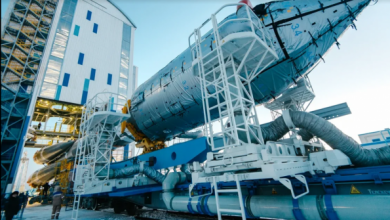AVIATION WEEK: Russian Soyuz-2 Poised For Launch At Vostochny
by Irene Klotz

Soyuz-2: GK Launch Services
VOSTOCHNY COSMODROME—A Russian Soyuz-2 rocket, outfitted with a Fregat upper stage, was being
prepared for launch from here in the Russian Far East on Dec. 27, marking the country’s 17th launch of the year,
placing it behind China and the U.S. in annual number of orbital launches.
The 167-ft. (51-m) three-stage Soyuz was rolled out to its launchpad on Dec. 24 in the midst of Siberian winter, with
predawn temperatures of minus 36F. It will be only a few degrees warmer at 11:07 a.m. local time/9:07 p.m. EST
Dec. 26 when the rocket is scheduled for launch, but the only weather concern will be the briskness of upper level
winds.
Mounted inside the 12-ft. (3.7-m) dia. payload fairing are the Russian government’s Kanopus-V 5 and 6 Earth
observation satellites and 26 smallsats, including 12 Dove cubesats owned and operated by San Francisco-based Planet.
The rideshares were arranged by GK Launch Services, which was established by the Russian space agency
Roscosmos in 2017 to market Soyuz-2 commercial launch services from Vostochny and the Baikonur Cosmodrome
in Kazakhstan. The Kanopus-V mission marks GK’s first mission.
The Dec. 27 launch will be Russia’s 17th and final orbital launch of the year, tying 2016 for the lowest annual flight
rate since 1961.
China, which was scheduled for its 41st flight of year on Dec. 29, finishes 2018 ahead of the U.S. in orbital launch
activity for the first time since 2012. United Launch Alliance (ULA) is aiming to close the year with a final Delta IV
Heavy flight, marking the country’s 35th orbital launch.
SpaceX accounted for 21 of the U.S. flights, including the Dec. 23 launch of the U.S. Air Force’s first GPS III satellite
on Dec. 23. ULA has completed eight, with a final mission for the National Reconnaissance Office planned for no
earlier than Dec. 30. Rocket Lab flew three missions, and Northrop Grumman flew its Antares rocket twice for NASA
International Space Station cargo runs.
